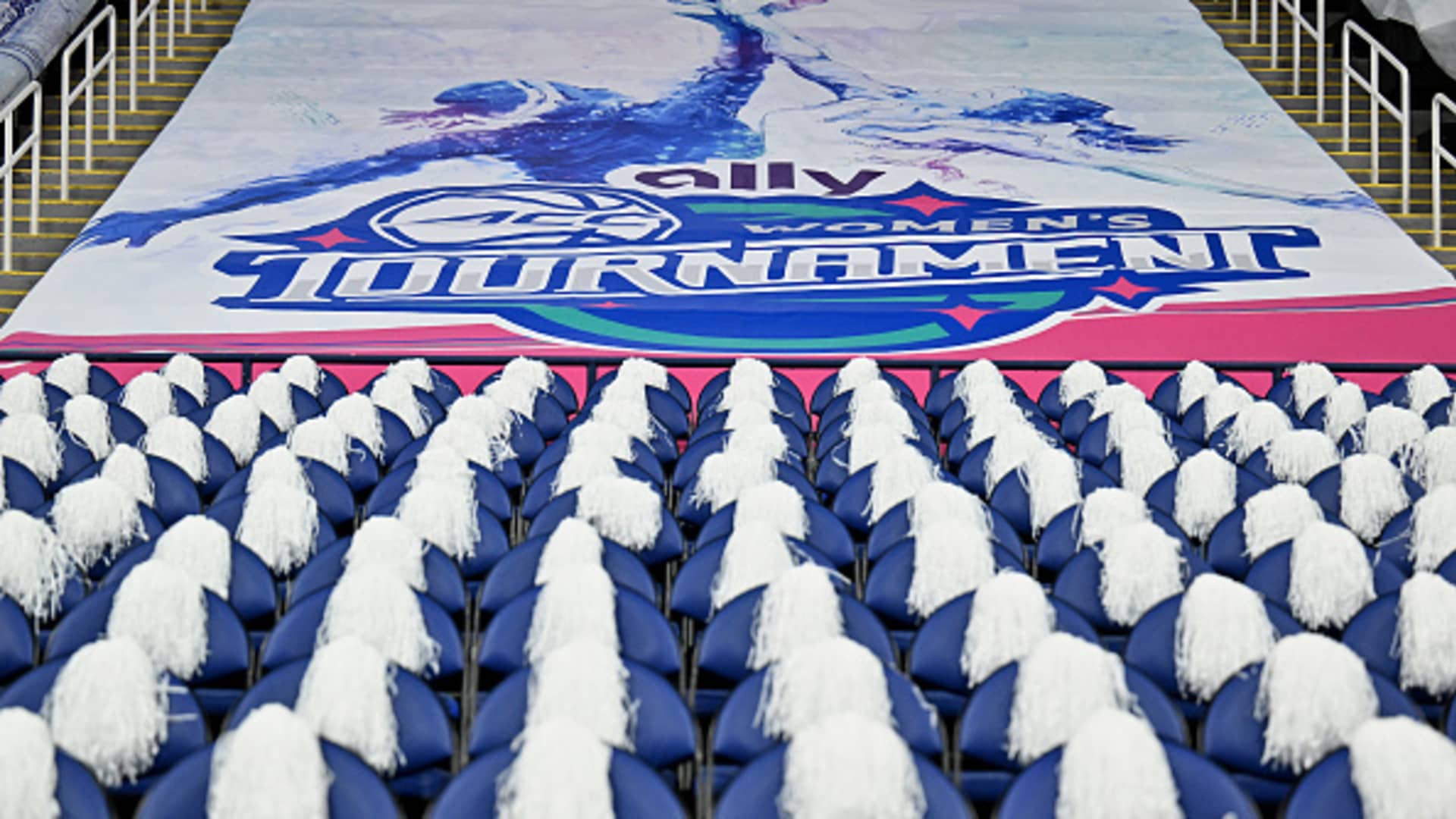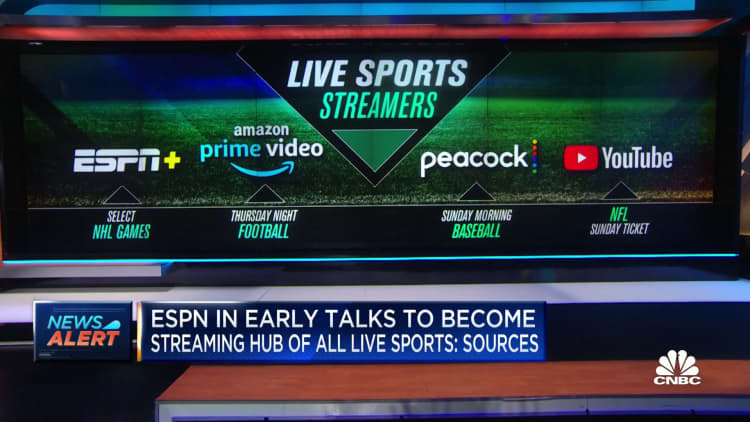
A detailed view of Atlantic Coast Conference signage before the game between the Wake Forest Demon Deacons and the Florida State Seminoles in the second round of the ACC Women’s Basketball Tournament at Greensboro Coliseum on March 02, 2023 in Greensboro, North Carolina.
Grant Halverson | Getty Images Sport | Getty Images
Female athletes are competing for greater fandom, higher viewership and more media coverage. A recent Ally Financial ad buy with Disney‘s ESPN focused on women’s sports may be the biggest deal yet — in importance as much as the dollars attached.
The one-year, multimillion-dollar deal requires 90% of its investment to be put to women’s sports, through expanding game highlights, branded content and features across ESPN.
“We really think it’s at the top of the funnel to create the most fundamental change for women’s sports,” said Stephanie Marciano, head of sports and entertainment marketing at Ally. “It is rare that brands buy media deals, or buy sponsorship deals, where they are as skewed toward women’s sports as this one,” she said.
The Disney deal is tied to a new three-and-a-half year Ally sponsorship of the Atlantic Coast Conference (ACC), whose conference tournament started this week, broadcasted on ESPN. The bank is the first-ever title sponsor for both the ACC Women’s Basketball Tournament and the ACC Women’s Soccer Championship, and will also be the exclusive presenting sponsor for the 2023 ACC Women’s Lacrosse Championship.
It’s part of a bigger change in the way Ally is spending its ad budget, with a five-year commitment to equally split paid advertising between women’s and men’s sports coverage.
“There’s just so much upside in women’s sports and so much that hasn’t been done yet, and I think marketers are recognizing that,” said Jon Patricof, CEO and co-founder of Athletes Unlimited, a network of professional women’s sports leagues.
Since making its five-year pledge, Ally collaborated with Paramount Global‘s CBS Sports and the National Women’s Soccer League (NWSL) to move the 2022 Ally Financial NWSL Championship to be aired in a prime-time broadcast window for the first time.
A big money year for women’s sports in 2022
Ally’s deal with Disney follows a successful year for women’s sports on the media front, with sponsorship deals growing 20% year-over-year, according to sports and entertainment intelligence platform SponsorUnited. In addition, the first-ever network to focus on female athletes, the Women’s Sports Network, launched this past fall and female college athletes have expanded their ability to secure NIL deals.
Alphabet‘s Google announced a multi-year partnership with sports website The Athletic in November that promises to double the amount of women’s sports coverage with a focus on soccer and the WNBA, as well as devoting more staffing and resources. Google had previously leveraged its partnership with the WNBA to help the league broadcast more games, including working with ESPN to ensure every playoff game was broadcast.
From Gatorade and Nike to Ally and Hilton Hotels & Resorts, more brands across more sectors are increasing ad budgets directed toward women’s sports. Athletes Unlimited, which operates basketball, softball, volleyball, and lacrosse leagues, saw sponsorship revenue increase by 122% year-over-year. It announced this week an extension of a deal it has had with Nike since the organization’s founding in 2020.

Social media engagement can be an added benefit for brands, according to Athletes Unlimited data. It cites average engagement on sports social media of less than 2%, versus Athletes Unlimited’s engagement rates closer to 5%. “So already over-indexing on engagement, and then if you look at our individual athletes, it’s like 11%,” Patricof said. That, in his view, is leading companies including Ally to recognize that an important and growing part of the value within sports’ social media engagement remains unrealized and untapped.
According to “name, image, and likeness” technology company and marketplace Opendorse, NIL-compensated female athletes are engaging in 19.6% more social media activities for their deals than male athletes, excluding football.
The proliferation of content across platforms is driving much of the action, said Patrick Rishe, director of the sports business program at Washington University in St. Louis. Brands understand there’s not only more content but women’s sports are a primary component of that content. Meanwhile, NIL deals in college athletics have created another avenue for women athletes to gain significant exposure.
“All of these things combine and just build this momentum,” Rishe said. “We can talk about people like Chloe Kim, the snowboarder. We can talk about Livvy Dunne, the gymnastics competitor at LSU. We can talk about Alex Morgan of the U.S. Women’s [National] Soccer Team. These are just three names, three different women at three different stages of their lives … all to a different degree leveraging social media, digital media to elevate their brands. Ten years ago, you wouldn’t have this,” he said.
Six women’s sports made the top 10 list for NIL-compensated sports, according to Opendorse, though in total dollar terms, men’s football and basketball command roughly 70% of the money, with NCAA football alone at just under 50%.
Olivia Dunne of LSU warms up on the uneven bars during a gymnastics meet against Auburn at Neville Arena on February 10, 2023 in Auburn, Alabama. (Photo by Stew Milne/Getty Images)
Stew Milne | Getty Images Sport | Getty Images
Sponsorship of women’s sports also provides brands access to what experts call “change” narratives.
“Purpose-driven” consumers now make up the largest segment of the buying public, at 44%, according to a recent IBM survey.
“Part of advertising and part of the reason you do these deals is you’re building this cultural capital with consumers,” Rishe said. “If you stand for equity, and you represent that by partnering with women’s sports, then you’re hoping that that’s going to resonate with your current customers. And perhaps it’s going to attract newer customers who align with that.”
That’s a big part of Patricof’s pitch to the world of corporate media buyers.
“In women’s sports, there’s right now a great opportunity to not only get direct return on your investment, but also pick up that very intangible value in the minds of fans and athletes,” he said.
For Ally, bigger deals and longer-term deals are the next step. “We’re feeling good about the trend, and I think that 20% number is going to continue to increase,” Marciano said of the revenue growth in 2022 for women’s sports sponsorships. “We have a big year ahead. So, we’re excited to kind of keep our foot on the gas for the rest of the year and show up at major women’s sports moments and events,” she added.
